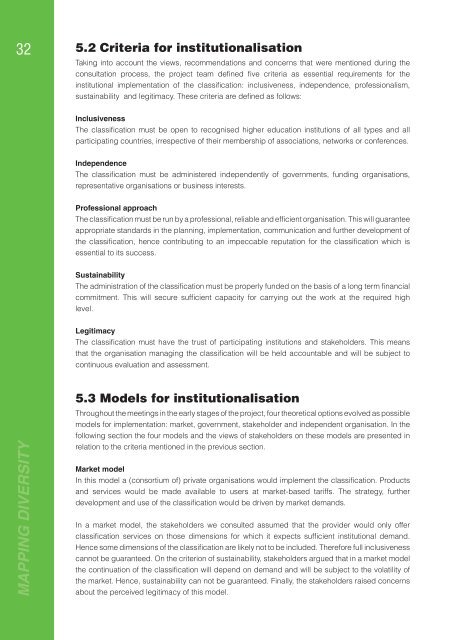Mapping Diversity: Developing a European Classification of ... - U-Map
Mapping Diversity: Developing a European Classification of ... - U-Map
Mapping Diversity: Developing a European Classification of ... - U-Map
Create successful ePaper yourself
Turn your PDF publications into a flip-book with our unique Google optimized e-Paper software.
32 5.2 Criteria for institutionalisation<br />
Taking into account the views, recommendations and concerns that were mentioned during the<br />
consultation process, the project team defi ned fi ve criteria as essential requirements for the<br />
institutional implementation <strong>of</strong> the classifi cation: inclusiveness, independence, pr<strong>of</strong>essionalism,<br />
sustainability and legitimacy. These criteria are defi ned as follows:<br />
Inclusiveness<br />
The classifi cation must be open to recognised higher education institutions <strong>of</strong> all types and all<br />
participating countries, irrespective <strong>of</strong> their membership <strong>of</strong> associations, networks or conferences.<br />
Independence<br />
The classifi cation must be administered independently <strong>of</strong> governments, funding organisations,<br />
representative organisations or business interests.<br />
Pr<strong>of</strong>essional approach<br />
The classifi cation must be run by a pr<strong>of</strong>essional, reliable and effi cient organisation. This will guarantee<br />
appropriate standards in the planning, implementation, communication and further development <strong>of</strong><br />
the classifi cation, hence contributing to an impeccable reputation for the classifi cation which is<br />
essential to its success.<br />
Sustainability<br />
The administration <strong>of</strong> the classifi cation must be properly funded on the basis <strong>of</strong> a long term fi nancial<br />
commitment. This will secure suffi cient capacity for carrying out the work at the required high<br />
level.<br />
Legitimacy<br />
The classifi cation must have the trust <strong>of</strong> participating institutions and stakeholders. This means<br />
that the organisation managing the classifi cation will be held accountable and will be subject to<br />
continuous evaluation and assessment.<br />
5.3 Models for institutionalisation<br />
MAPPING DIVERSITY<br />
Throughout the meetings in the early stages <strong>of</strong> the project, four theoretical options evolved as possible<br />
models for implementation: market, government, stakeholder and independent organisation. In the<br />
following section the four models and the views <strong>of</strong> stakeholders on these models are presented in<br />
relation to the criteria mentioned in the previous section.<br />
Market model<br />
In this model a (consortium <strong>of</strong>) private organisations would implement the classifi cation. Products<br />
and services would be made available to users at market-based tariffs. The strategy, further<br />
development and use <strong>of</strong> the classifi cation would be driven by market demands.<br />
In a market model, the stakeholders we consulted assumed that the provider would only <strong>of</strong>fer<br />
classifi cation services on those dimensions for which it expects suffi cient institutional demand.<br />
Hence some dimensions <strong>of</strong> the classifi cation are likely not to be included. Therefore full inclusiveness<br />
cannot be guaranteed. On the criterion <strong>of</strong> sustainability, stakeholders argued that in a market model<br />
the continuation <strong>of</strong> the classifi cation will depend on demand and will be subject to the volatility <strong>of</strong><br />
the market. Hence, sustainability can not be guaranteed. Finally, the stakeholders raised concerns<br />
about the perceived legitimacy <strong>of</strong> this model.

















